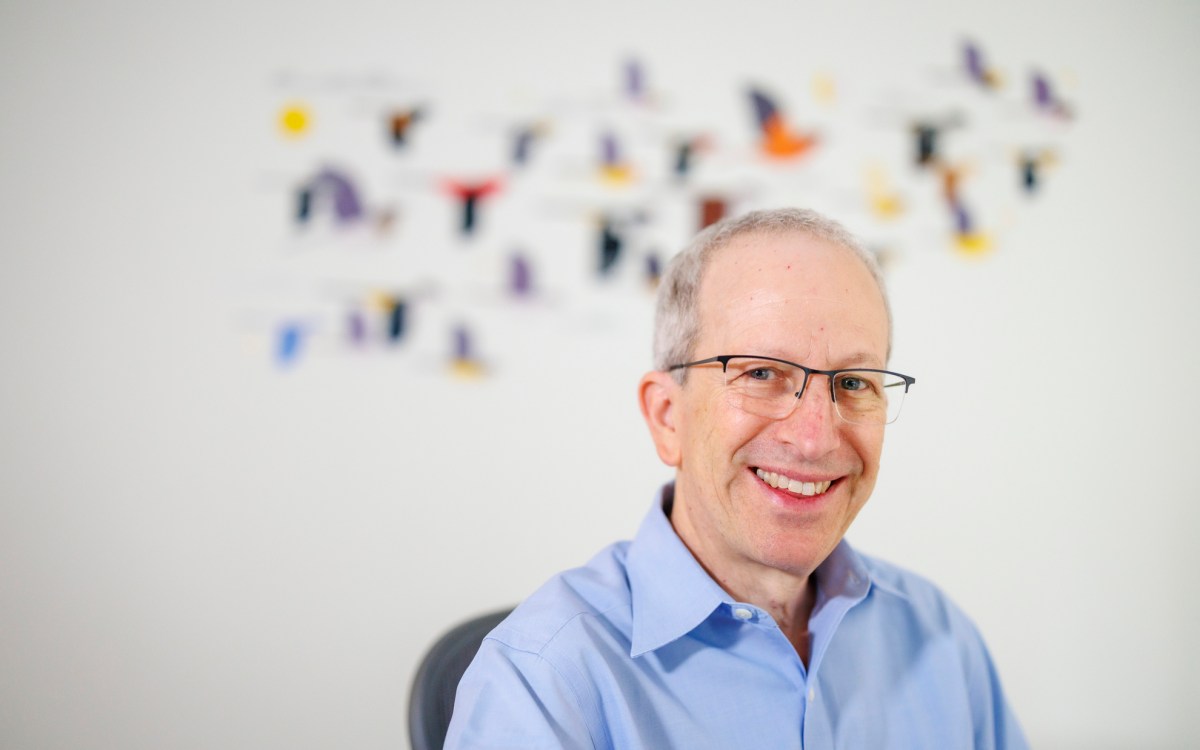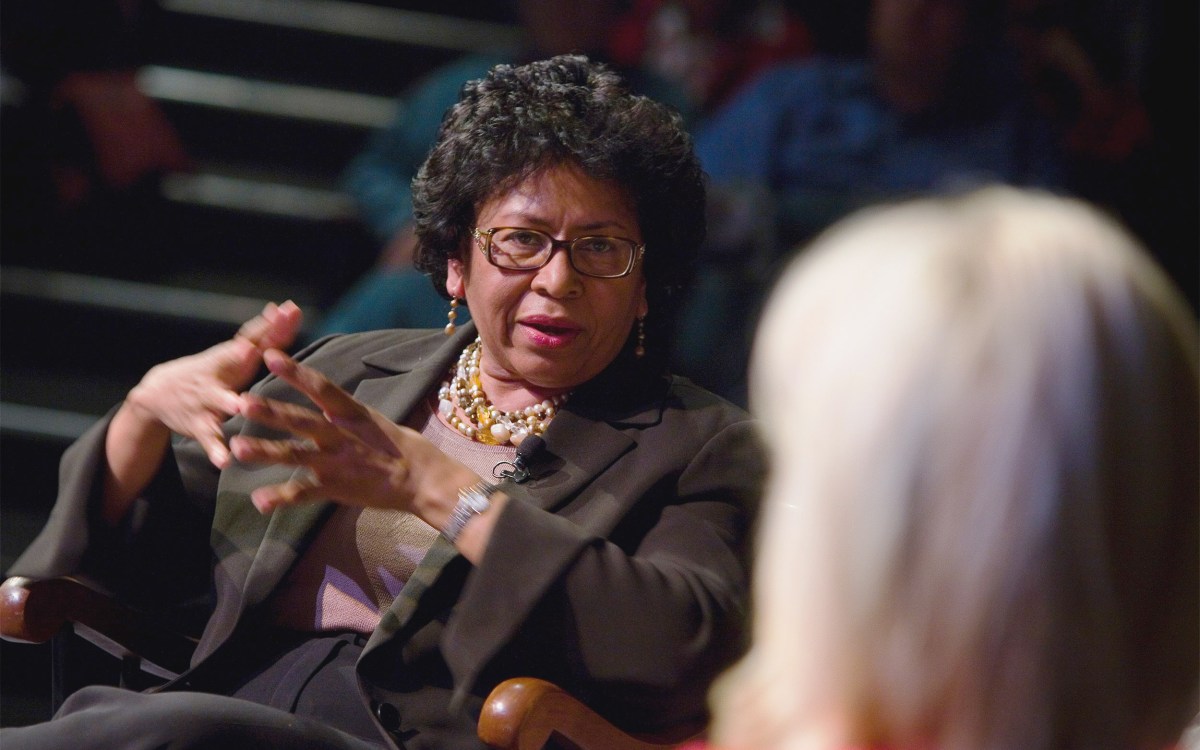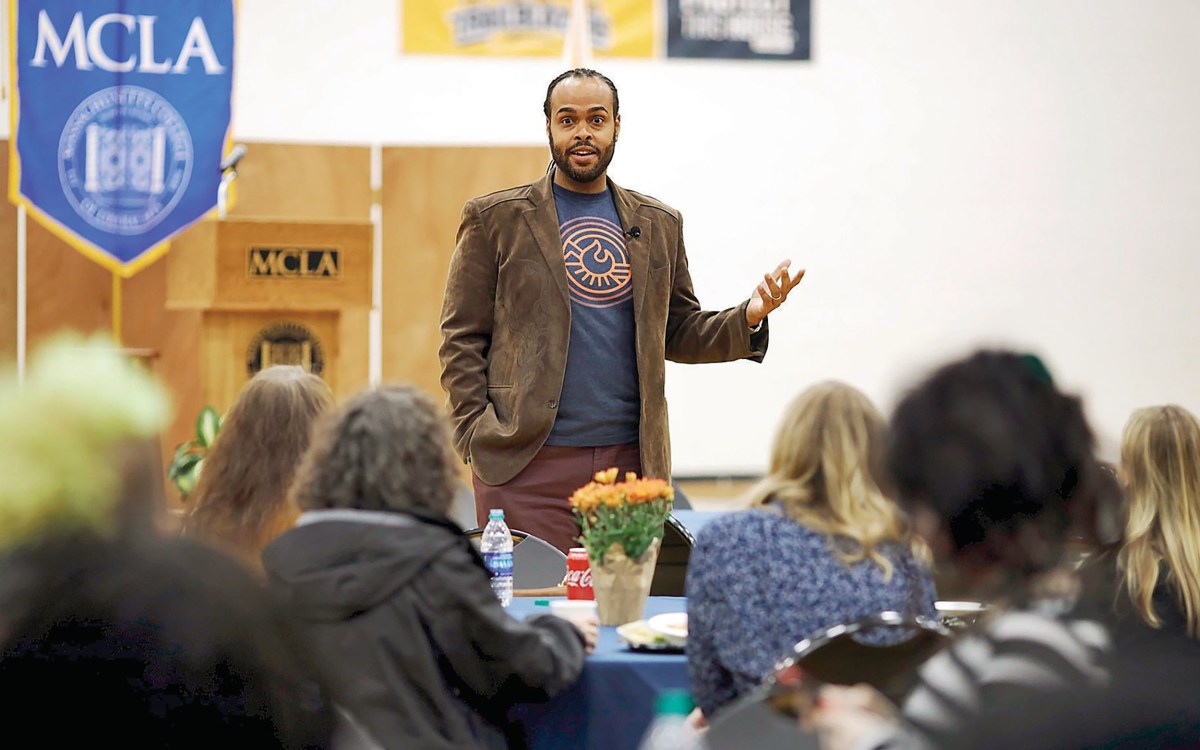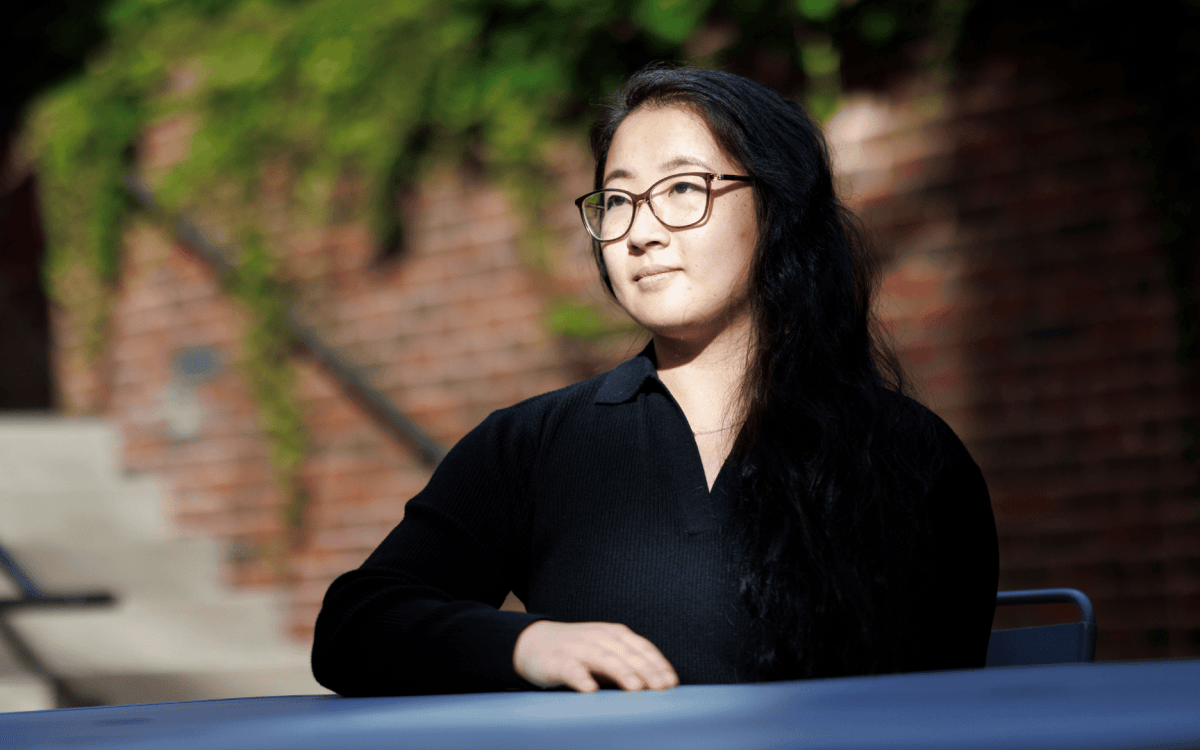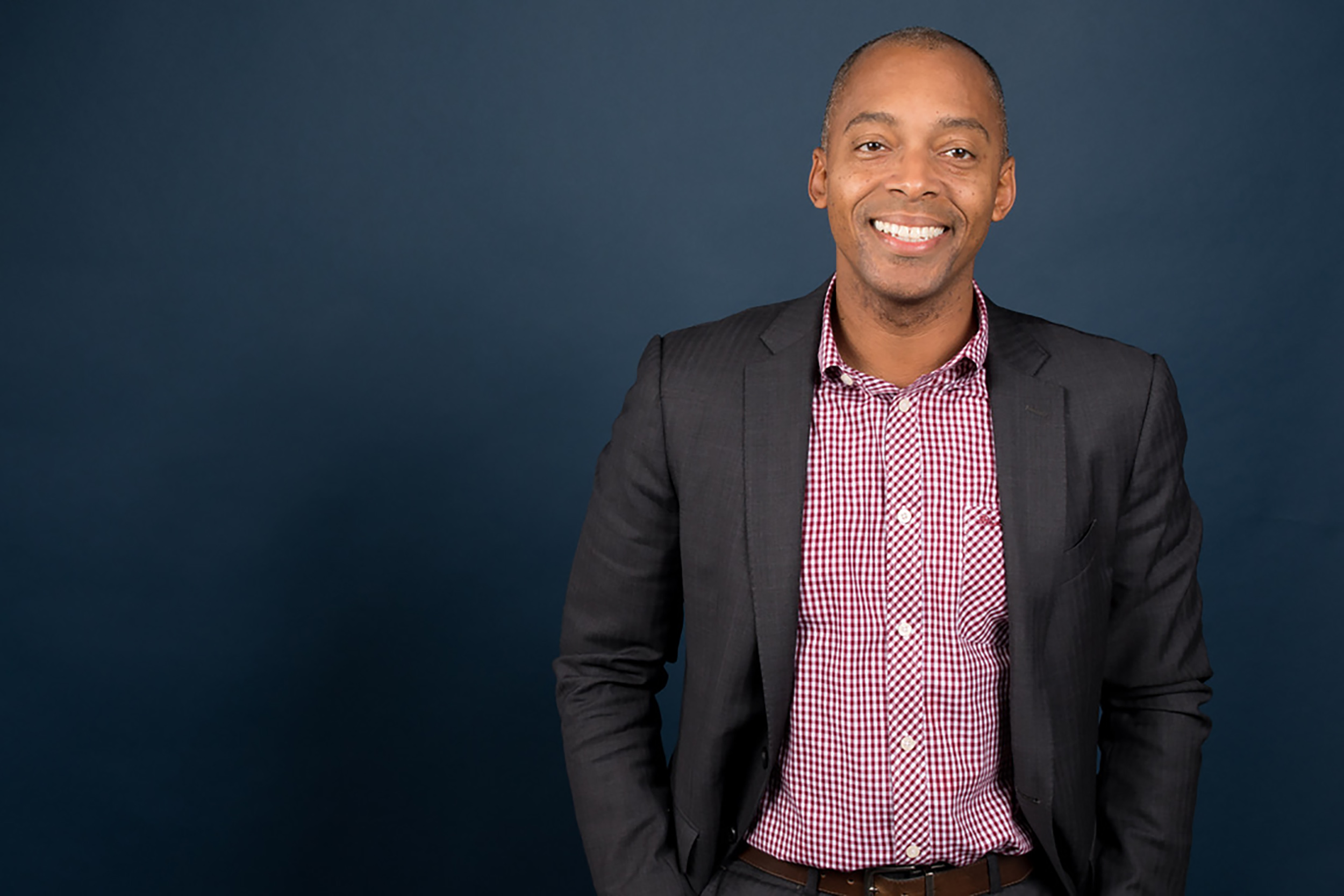
Khalil Gibran Muhammad is faculty director of the Institutional Antiracism and Accountability Project.
Photo by Martha Stewart
How to be an antiracist nonprofit or company
Kennedy School research initiative looks at why diversity and inclusion efforts succeed or fail
Recent killings of African Americans by police officers sparked widespread, multicultural, multigenerational protests and a reckoning around America’s history of anti-Black violence and systemic racism. Many nonprofits and businesses joined in the call for change, making new hiring, financial, and programmatic commitments and pledging to revise priorities and practices. The Institutional Antiracism and Accountability (IARA) Project, a research initiative of the Shorenstein Center at Harvard Kennedy School, studies the efficacy of steps that such organizations take to be more diverse and inclusive. The Project will convene a day-long webinar on Friday to discuss which practices work, which do not, and what to do about it. The Gazette spoke to project faculty director Khalil Gibran Muhammad, professor of history, race and public policy at HKS and the Suzanne Young Murray Professor at the Radcliffe Institute for Advanced Study, about the prospects for improvement.
Q&A
Khalil Gibran Muhammad
GAZETTE: What’s the objective of the IARA Project?
MUHAMMAD: The IARA project is a research project whose goal is to collect evidence of what’s working and not working largely in the private and nonprofit sectors where claims of diversity and inclusion or equity and belonging seem to fall short of changing the norms and practices of organizations. The project’s first phase is to examine published research both by academics and practitioners to produce meta-analysis research of what’s the best out there that we know of when it comes to racial equity in organizational behavioral change. In many ways, we are not doing anything more than some of our own colleagues, Frank Dobbin in sociology [and] Robert Livingston at the Harvard Kennedy School. We’re pretty interested in practitioner research as well and where research breaks down in the field — where are the gaps in knowledge of what works and in application of what works? Some of that comes out of research, but some of that comes out of trying to connect the dots between what people are saying that they’re doing. We do have a second phase of the project, which will be to identify a sample of organizations whose efforts at adopting equity and inclusion interventions are working and then to test or audit whether their claims of success actually hold up to further scrutiny. That’s not [yet] underway.
GAZETTE: What do you mean by racial equity?
MUHAMMAD: Racial equity, as we define it, would be policies, practices, and procedures that do not perpetuate discrimination or forms of bias in the workplace or in the business model itself. The classic example would be working for a company that advances predatory financial services in low-income communities of color. This is one lesson of the Great Recession and yet, it’s not clear that banks or any other financial services firms that have diversity standards in terms of hiring practices or affinity groups in terms of inclusion efforts, have robust policies to prevent pricing financial products differently because someone happens to be from a low-income community of color.
So part of the meta-analysis is to test the definition and application of the term itself. When researchers look for what counts as racial equity, how much heterogeneity is in the definition itself and in its application? There’s a lot of heterogeneity, and it’s that heterogeneity that contributes to the lack of clear demonstrable standards of racial equity that people can point to. Instead, it becomes a basket of goods that people say, “Well, we have a diversity officer” or “We have affinity groups” or “We’ve moved the needle on overall hiring of non-white staff.” And sometimes, of course, that means that you can look at the org chart and see that there’s bunching at the bottom and very little at the top.
“Some of the research suggests that companies have no intention of doing anything more than passing a symbolic litmus test, that is, ‘How do we look?’”
GAZETTE: What are the primary obstacles to racial equity in workplaces? Is it sins of commission, sins of omission, or both?
MUHAMMAD: They’re all of the above. Some of the research suggests that companies have no intention of doing anything more than passing a symbolic litmus test, that is, “How do we look? Do we have enough representation to satisfy customer expectations? Do we have the appropriate systems in place so that our own employees can feel included as affinity groups or employee resource groups?” A lot of companies are still hiring diversity officers for the first time, which is known as a weak adaptation to failures of achieving a company’s own diversity goals. We have good evidence that diversity officers are not very effective, [especially … when] firms really don’t expect to change the way they do business or the way their HR policies are established.
GAZETTE: Do firms generally see diversity and inclusion as a boon or a burden? Are most taking actions simply to avoid being “canceled” on social media?
MUHAMMAD: It’s hard to know for sure. There’s no regulation that requires companies to open their books to these kinds of audits, so we don’t have a lot of robust, rigorous research to be able to answer a question like that. A lot of what we have is general reporting, anecdotal evidence, whistleblower complaints, this sort of thing. Where our project is useful to the field is to the work of diversity consultants who are contracted to come in and do a racial audit at the company’s own request. A lot of times, that comes because there’s a leadership push: The board can push for it; the CEO can push for it; someone on the executive committee or in the senior ranks can push for it. Sometimes it can come as a result of embarrassing national scandal. There are lots of reasons, both internal and external, that can lead a company to take seriously the need for self-assessment.
GAZETTE: You say most racial diversity and inclusion efforts out there don’t work. Why not and what should firms and nonprofits be doing instead?
MUHAMMAD: One of the things that we’re noticing is that companies that are more honest about their past, whether it is a 200-year-old company or a 20-year-old company or a tech startup, there’s a good chance that given the existing racialized and gender power dynamics that exist in the United States, that unless you were intentional, you are not a very diverse place. The second question becomes: What are the blind spots of the leadership that prevented it from seeing areas of the company’s business model that might either be doing harm or be neglecting parts of the community it claims to serve, its stakeholders? Those two things, what we would call a historical reckoning — taking stock of how the company came to be and then acting intentionally to redress that past — would then lead a company to take affirmative, intentional efforts to: 1) diversify its personnel and 2) consider how the business model itself might be perpetuating racial inequality or institutional racism.
What might be counterintuitive is that a lot of companies lobby for favorable regulation. They lean into their ability to influence state or federal legislation, which could be a neutral effort which has no racial implications, or it could be a harmful effort. The deregulation of [the] financial services [industry in the 1990s] contributed to a cowboy culture in the financial sector. It was quite predictable who would be on the short end of that process. That’s one example that we can use as a case study. If companies are claiming, as many have, to not support racism or have written solidarity statements, then the question is: Is a company willing to use its lobbying muscle to argue for changes in police practices in jurisdictions in which it does business? Is it willing to argue for greater affordable housing legislation in the city councils where it’s incorporated? These would be taking what we know to be the intersection of the private sector and our political economy to heart and saying, “It’s not just about your bottom line if you really care about ending racism.”
“Sometimes, of course, that means that you can look at the org chart and see that there’s bunching at the bottom and very little at the top.”
GAZETTE: Accountability is critical to the project’s mission. How do institutions measure whether what they’re doing is truly having an impact, and if they’re not, what’s the most effective way to hold these institutions accountable and whose job is that?
MUHAMMAD: Surprisingly, we’re still in an era when companies don’t self-report very much data about their own stated diversity claims. They’re not required to. So that’s one area of accountability. If a company is serious, then it should have as robust a set of metrics for measuring what it considers racial equity as it does any other core operation. The bigger question though, how do you achieve accountability sector by sector, is one that IARA hopes to help put into the world.
We’re using the example of environmental building codes that promote sustainability, LEED standards, for example, as an aspirational goal for the IARA Project. If we could establish an accreditation process whereby companies that claim to be on a spectrum of diversity, racial equity, and anti-racism, where diversity goals that you’ve achieved might get you a bronze, racial equity would get you a silver, and then anti-racism would get you a gold standard because you’ve achieved it. Those benchmarks would be widely known and published and accepted like FASB [Financial Accounting Standards Board] Rules [or] Generally Accepted Accounting Principles. That’s the aspirational goal for the IARA Project.
GAZETTE: In 2019, the project held its first conference, which focused on diversity and inclusion shortfalls at the Kennedy School. A lot has happened in the country since then. What has been the effect of the protests calling for an end to systemic racism and police violence against Black people in the wake of George Floyd’s murder? Has anything changed in the business and nonprofit world since then, both for the positive and the negative?
MUHAMMAD: It’s too soon to see anything that would hold up to scientific scrutiny. But I would say that the rhetorical claims of renewed commitment or a first-time commitment to something systemic within the private sector are definitely new, as are the willingness of firms to allow time, space and ultimately, opportunity costs in terms of revenue-making, for their own employees to speak out loud about the climate of these firms. Aside from the solidarity statements, which are as much marketing and PR as they are anything else, a lot of companies have created space for this kind of truth-telling about the experiences of employees with different backgrounds. In the past, those conversations tended to be in limited spaces and were not compulsory for leadership and oftentimes did not extend beyond Black History Month, Women’s History Month, Latinx Heritage Month. That’s a big difference. That still won’t necessarily change the bottom line for a lot of companies, but raising the expectations of their own employees will likely cause both intended and unintended consequences for firms. We’ll just have to see what comes of it.
GAZETTE: What are some indications that things might really change?
More like this
MUHAMMAD: In a time of severe economic contraction, the first empirical sign that companies are doing things differently will be increased budgetary resources to support this kind of work and to create cost centers that allow employees to charge their time to spaces that are not really about making the company money, but more about the climate and culture of the company. Those are the things that will support the retention efforts of companies, which will have an impact overall for whatever diversity goals they claim to have. The stuff that isn’t going to be clear for a lot of firms is how will they lean into the societal challenges that many employees bring to work? Will they use their lobbying muscles? Will they use corporate philanthropy? Will they decide that there will be certain profit centers that will make less money going forward because they’re going to do things differently for the benefit of some racial-equity goal? Those are the things that will be harder to know in the near term.
Interview has been edited for clarity and length.
